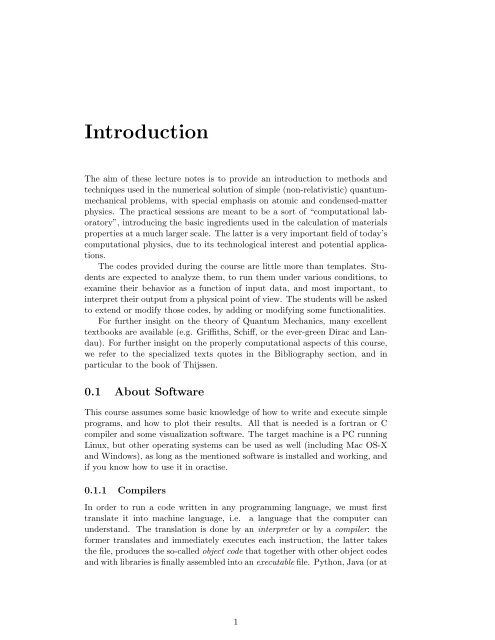Numerical Methods in Quantum Mechanics - Dipartimento di Fisica
Numerical Methods in Quantum Mechanics - Dipartimento di Fisica
Numerical Methods in Quantum Mechanics - Dipartimento di Fisica
Create successful ePaper yourself
Turn your PDF publications into a flip-book with our unique Google optimized e-Paper software.
Introduction<br />
The aim of these lecture notes is to provide an <strong>in</strong>troduction to methods and<br />
techniques used <strong>in</strong> the numerical solution of simple (non-relativistic) quantummechanical<br />
problems, with special emphasis on atomic and condensed-matter<br />
physics. The practical sessions are meant to be a sort of “computational laboratory”,<br />
<strong>in</strong>troduc<strong>in</strong>g the basic <strong>in</strong>gre<strong>di</strong>ents used <strong>in</strong> the calculation of materials<br />
properties at a much larger scale. The latter is a very important field of today’s<br />
computational physics, due to its technological <strong>in</strong>terest and potential applications.<br />
The codes provided dur<strong>in</strong>g the course are little more than templates. Students<br />
are expected to analyze them, to run them under various con<strong>di</strong>tions, to<br />
exam<strong>in</strong>e their behavior as a function of <strong>in</strong>put data, and most important, to<br />
<strong>in</strong>terpret their output from a physical po<strong>in</strong>t of view. The students will be asked<br />
to extend or mo<strong>di</strong>fy those codes, by add<strong>in</strong>g or mo<strong>di</strong>fy<strong>in</strong>g some functionalities.<br />
For further <strong>in</strong>sight on the theory of <strong>Quantum</strong> <strong>Mechanics</strong>, many excellent<br />
textbooks are available (e.g. Griffiths, Schiff, or the ever-green Dirac and Landau).<br />
For further <strong>in</strong>sight on the properly computational aspects of this course,<br />
we refer to the specialized texts quotes <strong>in</strong> the Bibliography section, and <strong>in</strong><br />
particular to the book of Thijssen.<br />
0.1 About Software<br />
This course assumes some basic knowledge of how to write and execute simple<br />
programs, and how to plot their results. All that is needed is a fortran or C<br />
compiler and some visualization software. The target mach<strong>in</strong>e is a PC runn<strong>in</strong>g<br />
L<strong>in</strong>ux, but other operat<strong>in</strong>g systems can be used as well (<strong>in</strong>clud<strong>in</strong>g Mac OS-X<br />
and W<strong>in</strong>dows), as long as the mentioned software is <strong>in</strong>stalled and work<strong>in</strong>g, and<br />
if you know how to use it <strong>in</strong> oractise.<br />
0.1.1 Compilers<br />
In order to run a code written <strong>in</strong> any programm<strong>in</strong>g language, we must first<br />
translate it <strong>in</strong>to mach<strong>in</strong>e language, i.e. a language that the computer can<br />
understand. The translation is done by an <strong>in</strong>terpreter or by a compiler: the<br />
former translates and imme<strong>di</strong>ately executes each <strong>in</strong>struction, the latter takes<br />
the file, produces the so-called object code that together with other object codes<br />
and with libraries is f<strong>in</strong>ally assembled <strong>in</strong>to an executable file. Python, Java (or at<br />
1
















